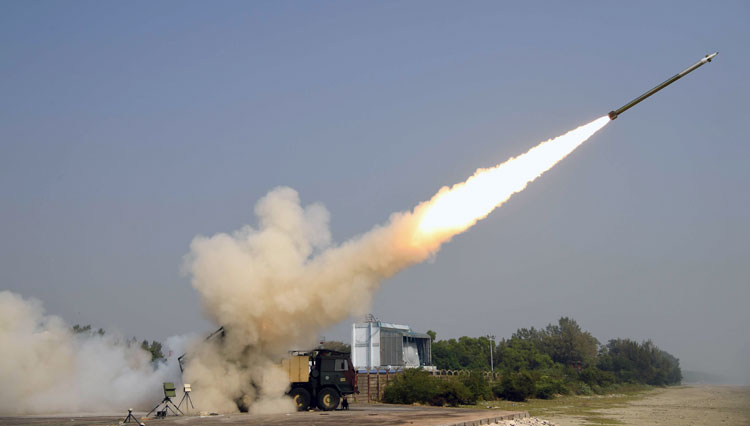INDIAN ARMED FORCES CHIEFS ON OUR RELENTLESS AND FOCUSED PUBLISHING EFFORTS

The insightful articles, inspiring narrations and analytical perspectives presented by the Editorial Team, establish an alluring connect with the reader. My compliments and best wishes to SP Guide Publications.

"Over the past 60 years, the growth of SP Guide Publications has mirrored the rising stature of Indian Navy. Its well-researched and informative magazines on Defence and Aerospace sector have served to shape an educated opinion of our military personnel, policy makers and the public alike. I wish SP's Publication team continued success, fair winds and following seas in all future endeavour!"

Since, its inception in 1964, SP Guide Publications has consistently demonstrated commitment to high-quality journalism in the aerospace and defence sectors, earning a well-deserved reputation as Asia's largest media house in this domain. I wish SP Guide Publications continued success in its pursuit of excellence.
- Prime Minister Modi Visits Punjab’s Adampur Air Base, Interacts with Airmen after Successful ‘Operation Sindoor’; Stern Message to Pakistan
- The layered Air Defence systems that worked superbly, the key element of Operation Sindoor
- Operation Sindoor | Day 2 DGMOs Briefing
- Operation Sindoor: India strikes back with Precision and Purpose
- Operation Sindoor: Resolute yet Restrained
- India’s Operation Sindoor Sends a Clear Message to Terror and the World – ‘ZERO TOLERANCE’
- Japan and India set forth a defence cooperation consultancy framework, talks on tank and jet engines
- Terrorist Attack in Pahalgam in Kashmir: Unfolding a long surgical war against PAK
- Lt General Pratik Sharma takes over Command of Indian Army's Northern Command
Pinaka rocket now an extended range guided missile
Modified missile test fired over a range of 75 km

India's Defence Research and Development Organisation (DRDO) has validated the enhancement of indigenous artillery bombardment capability to 75 km with the successful test firings of the extended range, guided Pinaka Mark-II rocket, which is now being termed a missile system.
"The Pinaka MK-II Rocket is modified as a missile by integrating with the Navigation (a) Control and Guidance System to improve the end accuracy and enhance the range. The Navigation system of the missile is also aided by the Indian Regional Navigation Satellite System (IRNSS)," the Ministry of Defence declared in a statement.
"The Pinaka MK-II Rocket is modified as a missile by integrating with the Navigation (a) Control and Guidance System to improve the end accuracy and enhance the range. The Navigation system of the missile is also aided by the Indian Regional Navigation Satellite System (IRNSS)," the Ministry of Defence declared in a statement
The extended range modified missile will be subjected to user trials as per programme deadlines.
The version currently in use by the Indian Army is an unguided 40-km range multi-barrel rocket system. The Army is presently equipped with 2 Pinaka regiments and an additional 2 are reportedly on order. The Ministry of Defence has also approved a tender for 6 more regiments. Earlier reports have suggested plans for 22 Pinaka regiments by 2030, also to replace the older Soviet-origin Grad. The new improvements make the Pinaka a far more potent and accurate weapon.
Two flight trials were conducted by the DRDO from the Integrated Test Range at Chandipur-on-Sea. The first on December 19 validated a range of 75 km. The second trial on December 20 was a salvo launch with two Pinaka missiles being fired with a 60-second gap. Both missiles were fired with live warheads on a target at a distance of 20-km.
The version currently in use by the Indian Army is an unguided 40-km range multi-barrel rocket system. The Army is presently equipped with 2 Pinaka regiments and an additional 2 are reportedly on order. The Ministry of Defence has also approved a tender for 6 more regiments. Earlier reports have suggested plans for 22 Pinaka regiments by 2030, also to replace the older Soviet-origin Grad. The new improvements make the Pinaka a far more potent and accurate weapon
"The mission objective of today’s trial was to test low range, functioning of live warhead along with its proximity initiation and salvo launch," the statement elaborated. The live warheads were fitted with a proximity fuse. The DRDO claimed high accuracy in hitting the target.
The missile system has been jointly developed by DRDO Laboratories Armament Research & Development Establishment (ARDE), Research Centre Imarat (RCI), Defence Research and Development Laboratory (DRDL), Proof & Experimental Establishment (PXE) and High Energy Materials Research Laboratory (HEMRL).





